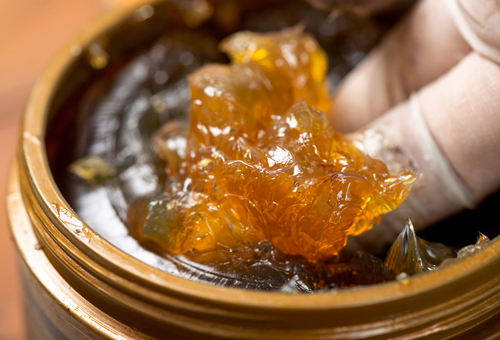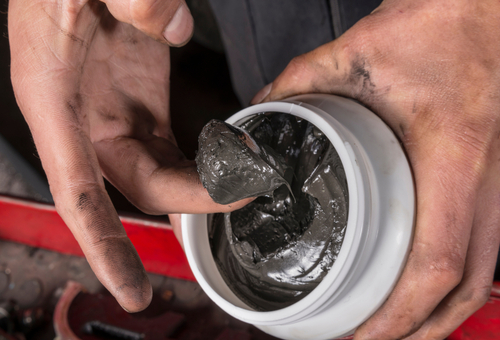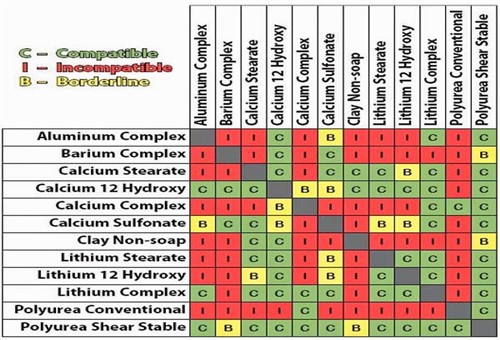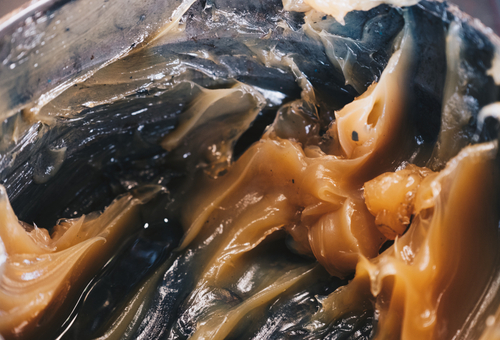
If you have been in the car repair industry for several years, you have no doubt seen automotive grease in all the colours of the rainbow. You have no doubt also seen grease in all possible consistencies; from soft like melted butter to semi-hard, to as hard as wax. There is also a high likelihood that you have on occasion used grease from the first container you could lay your hands on to pack wheel bearings or lube ball joints, because grease is just grease, after all. It’s just the colour that is different between brands, right?
It would be fair to say that most of us have on occasion used the first available grease to save time, and while mixing different grease formulations do not always result in immediate comebacks or component failures, mixing greases is really not a good idea- even if does sometimes save us a few minutes in getting something done during a busy day.
In practice, though, grease is often described as the "forgotten" lubricant, and in this article, we will take a closer look at grease in terms of what is, how it works, and why using the recommended grease for a particular application is important. Let us start with this question-

As a lubricant, grease has a very long history. Archeologists have found jars of animal fat mixed with finely powdered talcum, gypsum, and other powdered substances on ancient shipwrecks, in equally ancient tombs, among the ruins of 2000-year-old Roman fortifications, and in other archeological excavations.
On ships, animal fat-based grease was used to lubricate ropes and wooden pulleys, while on land, animal fat-based grease was used to lubricate the complex moving parts of machines of war and the axles of war chariots and cargo wagons. Written records from various parts of the ancient world also tell us that developing the perfect combination of fat and powdered minerals that resisted both being flung off fast-rotating parts and dilution by water was a kind of Holy Grail for many military engineers of the time.
In fact, there is some evidence to suggest that some of the military successes enjoyed by the Roman Empire had more to do with the quality of the lubricants they used on their heavy weapons than with the skill of their military commanders. One can only marvel at ancients’ persistence in always finding improved ways to keep their war machines well lubricated.
Nonetheless, ancient grease formulations had much in common with their modern counterparts. For example, mixing various concentrations of different animal fats improved the lubricity of the mixture, while the addition of various powdered substances both increased the melting point of the product and improved its adhesion to sliding and rotating parts.
Thus, in practice, we have to thank the ancients for saving us a lot of research time in developing lubricants that stuck to components, did not melt when parts got hot, and provided predictable levels of lubrication in any given application. However, the lubrication demands of modern industry in general, and modern vehicles in particular, are vastly more specialised than simply having to keep chariot wheels from seizing on their axles, so let us look at-
When talking about how modern grease formulations are developed, it is important to understand that no matter what oil and lubrication manufacturers would have us believe, there are no formulations that are intended for exclusive use on cars and trucks.
Of course, this is not the same as saying that we can, or should, use any grease formulation for any application on the vehicles we work on. What it means is that any particular grease formulation is designed around the tribological* requirements of various components, such as roller bearings, bushings, gears, and pivot points like ball joints and tie-rod ends, regardless of whether they are used on a car on in a steel mill.
* “Tribology” is a discipline within mechanical engineering that focuses onthe design, friction, wear, and lubrication of interacting surfaces (as bodily joints) in relative motion. (Source: Merriam-Webster)
We can use roller bearings as an example of this, and while we need not delve into the history and development of roller bearings here, we can say that roller bearings as we know them today, were in widespread industrial use long before the first cars were invented. Therefore, while the dimensions of roller bearings were sometimes adapted to make them suitable for use in the first cars, the basic design principles of roller bearings were already well established when the first cars appeared. Moreover, 19th-century inorganic chemistry provided the means to develop effective lubricants for early bearing designs, and all that has changed since then and now are the availability of some new chemicals to put into grease, and improved methods to manufacture bearings.
So what does all, or any, of the above mean for us, as technicians in a modern world? It simply means this: there are no technical differences between the tapered roller bearings or the double-row ball bearings we install in the hubs of modern vehicles, and identical bearings a technician would install into an industrial machine in say, a steel mill, commercial bakery, or a printing works.
The only differences between an automotive and an industrial application* for any given bearing involve both the type and formulation of the lubricating grease used in the bearing.
*For the purposes of this article, we can assume that in all cases, the thermal expansion ratings of the bearings are all the same.
The above is perhaps putting too fine a point on things, but three things bear repeating, these things being the facts that-
The above is saying a lot, but to provide some context for the last point, we could consider the following, assuming that the same bearing is used in all three of our example applications-
So in practice, selecting the correct grease formulation for say, wheel bearings in light vehicles is less about wondering if a grease formulation recommended by Ford for their wheel bearings will work on say, Toyota or VW wheel bearings, and more about selecting a grease formulation according to-
The acronym L.E.T.S stands for Load, Environment, Temperature, and Speed, which are the four most important criteria that must be considered when selecting a lubricating grease formulation for a particular application- given that any bearing can have multiple applications in a variety of industries.
Note that while these criteria are neither designed, nor intended to replace or supplant actual technical specifications, following the recommendations implicit in the L.E.T.S. principle makes selecting an appropriate formulation a whole lot easier than trying to decode the sometimes-confusing technical lubrication specifications car manufacturers publish.
Unfortunately, limited space precludes the inclusion of all examples of the L.E.T.S principle here, but we can include one aspect of it, i.e., the recommended formulation for wheel bearing greases commonly used on wheel bearings in light vehicles. Note though that while this example applies to grease formulations made and supplied by Penrite Oil, other manufacturers and vendors will have their own names and designations for greases with equivalent performance standards or ratings. Consider the table below-
|
Load |
||||
|
Load |
ISO (Viscosity) |
NLGI Index |
Additives/Base |
Recommended Grease |
|
High |
220 460 680 |
1-2 |
High Base Oil Viscosity EP & AW Additives |
Extreme Pressure Grease ACT Grease XEP2 High Temperature Wheel Bearing Grease |
|
Low |
100 150 220 |
2-3 |
Low Base Oil Viscosity Firm Consistency |
Indgrease Lith R3 Indgrease 100 LXEP2 |
Source: https://www.penriteoil.com.au/assets/tech_pdfs_new/Nov2015/Greases.pdf
Similar tables and recommendations exist here for Environment, Temperature, and Speed, so let us consider some of the details of this table in the following sections, but before we get to specifics, we need to answer this question-
We don't often think about exactly what grease does, and how it does it, but consider some of the minimum requirements all lubricating grease formulations must have. In as few words as possible, all grease formulations are expected to do the following-
Seeing that a charge of lubricating grease must do all of the above over periods that can stretch into years, it would be reasonable to ask how grease works without breaking down. Here is how-
All grease formulations start off as base oils, to which a package of additives that include thickeners, friction modifiers, corrosion inhibitors, water repellents, viscosity stabilizers, various dyes, and many others is added to produce a paste that we know as grease.
However, the oil content of some grease formations can be as low as 5 percent, although a rough estimate puts the oil content of most formulations at between about 10 percent to as high as 20 percent. As a practical matter, all of the additives are chosen both for their compatibility with other additives in the same formulation, and their ability to hold the oil component in suspension even when the entire charge of grease is in motion, such as when some grease rotates along with a wheel hub.
So, when some grease passes between the rollers and the race surface, the pressure in the bearing’s load zone squeezes some oil out of the matrix, and it is this oil that provides the actual lubrication to the bearings’ moving surfaces.
Some of the squeezed-out oil is reincorporated into the matrix of binders and additives when the grease moves out of the load zone. At some point though, all the oil and the additives that make the oil into an efficient lubricant gets "used up", in much the same way that additives in engine oil are used up or degraded to the point where it can no longer provide an engine with adequate lubrication.
When we replace wheel bearings, we sometimes find hard, waxy lumps of dried grease in the hub. What we see is grease from which all the oil had been squeezed out over several years of use, and the hard waxy lumps are what remains of at least some of the additives, thickeners, and binders that constituted the matrix of the original grease formulation, which brings us to-

Source: https://thelubepage.com/amsoil-magazine-articles/magazine-articles/articles/grease-for-your-vehicle
The chart shown above illustrates the compatibility (or otherwise) of some of the principal components of grease formulations that are commonly available to the car repair industry. However, what this chart (and others like it) does not show is the compatibility of some of these constituents with the base oils that form the foundation of any grease formulation.
The problem is this: since the principal active lubricant in grease formulations is oil, all grease manufacturers and/or formulators strive to use the best possible oils, which could be either mineral or synthetic, or in some cases, a blend of mineral and synthetic oils. Thus, in a practical sense, it hardly matters whether the oil in any grease derives from crude oil or if it is of synthetic origin, provided there is no trace of any other grease in the component that can mix with the new grease. (Italics added for emphasis)
Why is this important? It is not only important- it is in fact, critically important because some of the oils used in grease formulations are not only incompatible; in some cases, some oils, which include-
are, in fact, antagonistic, which means that one oil can actively destroy the molecular structure of an incompatible oil. When this happens, the entire matrix of both grease formulations is dismantled, and both greases separate into their constituent parts, which leaves the bearing (or other components) with no lubrication at all. This process is somewhat analogous to what happens when incompatible synthetic engine oils are mixed- the entire mixture turns into a gelatinous mass that provides the engine with no lubrication.
You might have seen this process in action; wheel bearings or other components like universal joints and/or CV joints that failed although they appeared to be adequately lubricated with plenty of grease in evidence. There may have been plenty of grease in and around the component, but it was almost certainly grease that had separated into its constituent parts because of contamination with an incompatible grease.
So what does the above mean? Does it mean we can never, or should never deviate from manufacturers’ recommended greases? Well, no, it does not mean we should never deviate, but that begs the question of-

In the real world, there are many legitimate reasons why we might be forced to deviate from manufacturer-specified grease. For instance, a customer might have taken up off-road driving as a hobby and is now suffering frequent wheel bearing failures as a result of water intruding into his vehicles' wheel hubs.
In such a case, we might be forced to replace the existing grease in the hubs with a formulation that was designed specifically to resist the effects of water on bearings and other rotating components. The problem is, however, that there are many such formulations available, so how do we know which one will provide both the best lubrication and protection against water intrusion?
One way would be to ask your local parts supplier for recommendations, but the people in these establishments are rarely lubrication specialists, but then again, that is typically not a requirement to sell car parts. So, here is what we suggest you do-
Go to the official website of a national supplier like Penrite Oil, and read what they have to say about waterproof grease formulations. They basically state that although there is no such thing as a totally waterproof grease, some formulations do resist water, and some do it better than others do. Also, note that all reputable suppliers, of which there are many, will label some products with information such as “No Substitute Allowed”, “Preferred”, “Alternative to…”, and the like.
Following these recommendations will usually lead you to the most suitable alternative, but if we can offer one more piece of advice, it would be to avoid consulting compatibility charts.
There are three problems with these charts. The first is that-
This last point is rather important, because who among us knows what chemicals make up say, the lithium/calcium mixed complex in a grease formulation? More to the point, what does this group of chemicals do, and what about it makes it compatible or incompatible with any other complex of substances? Worse, though, how many among us know how any chemical in any grease may or may not react with say, ester-based synthetic oil in any other grease formulation that might be based on mineral oil?
At first reading, questions like these might seem pointless because we never see repacked wheel bearings or just-lubed universal joints fail within minutes after a customer drives off. Then again, we might never see that customer again, because he took his business elsewhere after his recently-serviced wheel bearings failed a few thousand kilometres after we had repacked them with the wrong grease.
Therefore, to avoid issues like this, this writer would suggest that you obtain a copy of the L.E.T.S. principle that applies to at least one reputable grease manufacturer/formulator/supplier because such a document can be hugely helpful. They are helpful because instead of listing specifications and ingredients we do not always understand, they recommend grease formulations that are suitable for a range of loads, environments, temperatures, and speeds, which means that we simply have to pick a product from a list of valid options.
Moreover, L.E.T.S. principle lists also usually list greases by their actual trade names, meaning that if you buy two containers of any particular grease two months apart, you can be sure that both containers will contain the same grease formulation. Therefore, you will not have compatibility issues to deal with in the form of a potentially expensive comeback, which leaves us with this-
We mentioned elsewhere in this article that grease is often referred to as the "forgotten" lubricant. This seems odd, seeing that it is grease that keeps critical components like wheel bearings, universal joints, CV joints, manual steering racks, ball joints, and tie-rod ends moving freely.
On the other hand, how often do we ascribe failures of these components to poor quality, factory flaws, design flaws, or the poor state of the road network? We have all seen grease-lubricated parts fail well before their due time so maybe, if we think about it, bad roads or “design flaws” may not be the root cause of these failures, after all.
Perhaps the quality and compatibility of the grease we pump into these components may have something to do with it. Nevertheless, what do you think- are you always sure you are using the most suitable grease formulations on your customers’ vehicles?